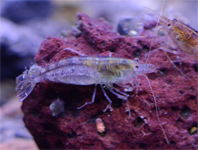Abstract
Macrobrachium indicum, a south Indian freshwater prawn described from Vellayani lake, Kerala is closely related to Koua river prawn, M. australe which in turn resembles M. ustulatum. Morphologically the three species pose difficulties in identification. A comparison of morphological characters of M. indicum, M. australe and M. ustulatum has been made in the paper. The COI sequence data for the species has been generated and made comparison with the existing COI barcode sequences for M. australe and showed clear difference between the species, thereby established the taxonomic validity of the species. Alignment of the present study sequences with reported sequences of M. australe revealed homologous region of 434 bp. Out of 434 nucleotides, the number of conserved and variable nucleotides were 313 and 121, respectively. Based on the P value (0.002) of Mann-Whitney U test, it was observed that the GC content at codon third base position between M. indicum and M. australe is significantly different. Because of the complexity of the species group a type material is highly necessary for confirmation in future studies and since holotype is irrecoverably lost, a neotype has been selected from the present collection and deposited in the CMFRI Museum at Kochi, Kerala with accession number: ED.2.2.1.8.
References
Abraham, R.K., Kelkar, N. & Kumar, A.B. (2011) Freshwater fish fauna of the Ashambu Hills landscape, southern Western Ghats, India, with notes on some range extensions. Journal of Threatened Taxa, 3 (3), 1585–1593.
https://doi.org/10.11609/JoTT.o2528.1585-93
Castelin, M., de Mazancourt, V., Marquet, G., Zimmerman, G. & Keith, P. (2017) Genetic and morphological evidence for cryptic species in Macrobrachium australe and resurrection of M. ustulatum (Crustacea, Palaemonidae). European Journal of Taxonomy, 289, 1–27.
https://doi.org/10.5852/ejt.2017.289
Covich, A.P., Palmer, M.A. & Crowl, T.A. (1999). The role of benthic invertebrate species in freshwater ecosystems: zoobenthic species influence energy flows and nutrient cycling. BioScience, 49 (2), 119–127.
https://doi.org/10.2307/1313537
da Silva, J.M., Creer, S., Dos Santos, A., Costa, A.C., Cunha, M.R., Costa, F.O. & Carvalho, G.R. (2011) Systematic and evolutionary insights derived from mtDNA COI barcode diversity in the Decapoda (Crustacea: Malacostraca). PLoS ONE, 6 (5), p.e19449.
https://doi.org/10.1371/journal.pone.0019449
De Grave, S. & Fransen, C.H.J.M. (2011) Carideorum catalogus : The recent species of the dendrobranchiate, Stenopodidean, Procarididean and Caridean shrimps (Crustacea : Decapoda). Zoologische Mededelingen, 85 (9), 195-588.
https://doi/ISBN/978-90-6519-200-4
Hebert, P.D.N., Cywinska, A., Ball, S.L. & de Waard, J.R. (2003) Biological identifications through DNA barcodes. Proceedings of the Royal Society B: Biological Sciences, 270 (1512), 313–321.
https://doi.org/10.1098/rspb.2002.2218
Hebert, P.D.N. (2004) Identification of birds through DNA barcodes. Public Library of Science Biology, 2, 1657–1663.
https://doi.org/10.1371/journal.pbio.0020312
Huang, J., Zhang, A., Mao, S. & Huang, Y. (2013) DNA Barcoding and Species Boundary Delimitation of Selected Species of Chinese Acridoidea (Orthoptera: Caelifera). PLoS ONE, 8 (12), e82400.
https://doi.org/10.1371/journal.pone.0082400
Jayachandran, K.V. & Indira, B. (2010)Sustainable exploitation of freshwater prawn diversity of India for food and livelihood security with emphasis on planning. Indian Journal of Scientific Research, 1 (2), 127–132.
Jayachandran, K.V. & Joseph, N.I. (1986) On a new species of Macrobrachium (Decapoda, Palaemonidae) from the south-west coast of India. Crustaceana, 50 (2), 217–224.
https://doi.org/10.1163/156854086X00232
Jayachandran, K.V. (2001) Palaemonid prawns: Taxonomy, Biodiversity, Biology and Management.Science Publishers, Inc., USA, 625.
Jayachandran, K.V., Thomas, T. &Raji, A.V. (2008) Caridinian shrimp resources of Kerala waters (Decapoda: Atyidae). In Proceedings of IndianNational Science Academy, (2), 47–50.
Jose, D., Nidhin, B., Kumar, P.K., Pradeep, J.P. &Harikrishnan, M. (2015) A molecular approach towards the s the taxonomy of fresh water prawns Macrobrachium striatum and M. equidens (Decapoda, Palaemonidae) using mitochondrial markers. Mitochondrial DNA, Early Online, 1–9
https://doi.org/10.3109/19401736.2015.1041114
Kumar, S., Stecher, G. & Tamura, K. (2016) MEGA7: Molecular Evolutionary Genetics Analysis Version 7.0 for Bigger Datasets. Molecular Biology and Evolution, 33 (7), 1870–1874.
https://doi.org/10.1093/molbev/msw054
Lim, H., ZainalAbidin, M., Pulungan, C.P., de Bruyn, M. &MohdNor, S.A. (2016) DNA Barcoding Reveals High Cryptic Diversity of the Freshwater Halfbeak Genus Hemirhamphodonfrom Sundaland. PloS ONE, 11 (9), e0163596.
https://doi.org/10.1371/journal.pone.0163596
Mariappan, P., Balamurugan, P. & Balasundaram, C. (2002) Diversity and utilization of freshwater prawns (Macrobrachium) in River Cauvery in Tamil Nadu. Zoos’ Print Journal, 17 (10), 919–920.
https://doi.org/10.11609/JoTT.ZPJ.17.10.919-20
Pillai, P.M. & Unnikrishnan, V. (2013) Description of a new subspecies, Macrobrachiumaemulummadhusoodani (Decapoda: Palaemonidae) from Neyyar River, Kerala, S. India. Zootaxa, 3722 (1), 50–60.
https://doi.org/10.11646/zootaxa.3722.1.4
Radhakrishnan, E.V., Deshmukh, V.D., Maheswarudu, G., Josileen, J., Dineshbabu, A.P., Philipose, K.K., Sarada, P.T., Pillai, S.L., Saleela, K.N., Chakraborty, R.D. & Dash, G. (2012) Prawn fauna (Crustacea: Decapoda) of India-An annotated checklist of the Penaeoid, Sergestoid, Stenopodid and Caridean prawns. Journal of the Marine Biological Association of India, 54 (1), 50–72.
Raghavan, R., Dahanukar, N., Philip, S., Iyer, P., Kumar, B., Daniel, B. & Molur, S. (2015) The conservation status of decapod crustaceans in the Western Ghats of India: an exceptional region of freshwater biodiversity. Aquatic Conservation: Marine and Freshwater Ecosystems, 25 (2), 259–275.
https://doi.org/10.1002/aqc.2490
Sheeja, R.V., Joseph, S., Jaya, D.S. & Baiju, R.S. (2011) Land use and land cover changes over a century (1914–2007) in the Neyyar River Basin, Kerala: a remote sensing and GIS approach. International Journal of Digital Earth, 4 (3), 258–270.
https://doi.org/10.1080/17538947.2010.493959
Valarmathi, K. (2009) A checklist of freshwater prawns of the families: Atyidae and Palaemonidae reported from India, Zoological Survey of India. e-News Vol. 1 (2), 16–19.
Zimmermann, G., Van Wormhoudt, A., Marquet, G., Ameziane, N., Defaye, D., Valade, P. & Keith, P. (2016) Phylogenetic relationships of the freshwater prawns Macrobrachium(Crustacea: Decapoda: Palaemonidae) of the Indian and west Pacific Oceans and evidence for the occurrence of a cryptic species within M. australe (Guerin-Meneville, 1838). NCBI gene bank. Available from: https://www.ncbi.nlm.nih.gov/genbank/barcode (Accessed 6 Aug. 2019)

